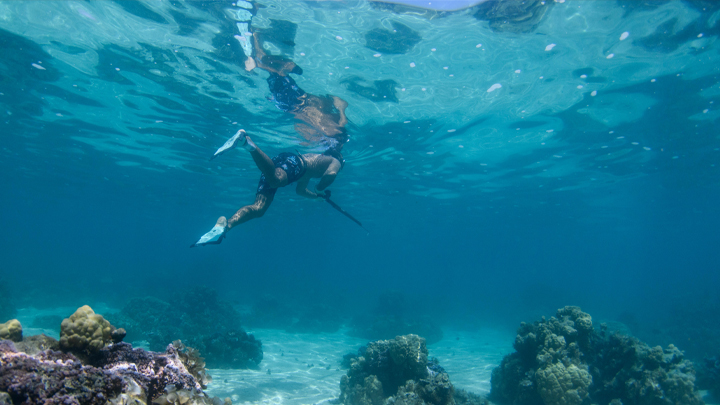SDSU anthropologists in Tahiti monitor effects of temporary fishery closures
The community of Parpara on the south coast of Tahiti opened their marine reserve, which they call rāhui, for the first time in four years and SDSU researchers were there to study the process.

Throughout French Polynesia communities are reinstituting a form of traditional resource management. Prior to European colonization Polynesians closed sections of their reefs for several years and then opened them to harvest fish for important events like feasts or the marriage of important leaders. Instead of permanent marine closures, rāhui closures are opened to allow fishers to harvest fish and monitor the state of the marine ecosystem.
Building on this ancient Polynesia practice, the rāhui in Papara was opened for two days on two different days (Feb. 14 and Feb 28, 2024) from 8 a.m. to 3 p.m. Our research team, which includes ecologists from UC Santa Barbara, was invited to monitor the entire process for the Feb 14 opening. We conducted underwater fish surveys prior to the opening to assess the state of the coral reef fishery and we will be conducting follow up surveys in the coming months to assess the impact of the one day opening. We also had anthropologists live in the community for two months before the opening to conduct interviews with the fishers and stakeholders.
During the opening we monitored the number of boats and fishers out on the water, interviewed fishers about the state of lagoon resources, and measured their catch using photographic methods. As part of this research our team is also conducting work on the growth rates of fish within marine reserves so some of the fish were dissected for that purpose.
Our initial results suggest that rāhui was partially successful in terms of protecting the marine ecosystem and had big effects building cohesion among the fishers and the rāhui management committee. Many fishers in our interviews stated that after a four-year fishing moratorium there should have been many more fish. The reason, they suggested, is that there has been frequent nighttime poaching in the rāhui. The fishers, with our help, are now attempting to encourage the French Polynesia government to grant them more power to monitor and enforce the rules of the rāhui.
Many fishers stated that holding an event like a one-day opening provides an opportunity for fishers to meet and celebrate their management initiative, increasing social cohesion and trust.
Understanding dynamic social-environmental feedbacks in temporary fisheries closure
I am currently involved in a $1.6 million project initiative awarded by National Science Foundation’s Dynamics of Integrated Socio-Environmental Systems (DISES) program.
I along Anastasia Quintana (UCSB), Steve Gaines (UCSB), Hunter Lenihan (UCSB), and Erendira Aceves Bueno (Univ. of Washington) will study one of the most vexing questions for the continued health of our oceans: How do we best manage coastal fisheries in manner that is both ecological beneficial and socially acceptable for the people who depend on them for their food and livelihood? Around the world over a billion people in coastal communities, especially in the developing world, depend on small-scale fisheries for seafood and income yet many are threatened by climate-change and overfishing.
To better manage these fisheries, scientists have long advocated for permanently closing some marine areas to fishing as means to sustain the fisheries. Yet despite the well documented ecological benefits of these permanent marine protected areas or “MPAs” there is growing recognition that more often than not local people do not embrace them, and they fail. Instead, many fishing communities prefer to close areas to fishing for a limited amount of time and then reopen them, a strategy that was employed for millennia throughout the Pacific Islands as a traditional fisheries management practice and that is gaining steam through grass-roots movement around the world. It remains an open question, however, how well temporary closures work, what social ecological effects they many have, and more broadly who deems them a failure or success?
To address these questions, our research group will be working with local stakeholders to study temporary closures in French Polynesia and Mexico. In both places temporary closers have grown in popularity and the research team intends to assess how different stakeholders such as fishers, scientists, non-governmental organizations, or government agencies interpret outcomes and decide that the reserves are successes or failures. Our team’s overall goal is to develop a decision-support tool to assist fishing community organizations to design and redesign closures. Their approach has the potential to provide a more descriptively accurate and illuminating account of how temporary marine reserves emerge and evolve and how success is produced in action.
